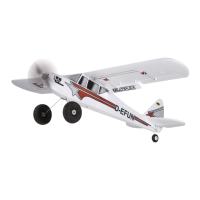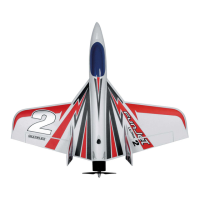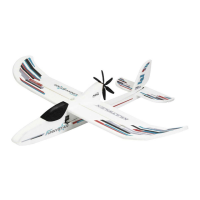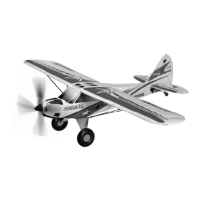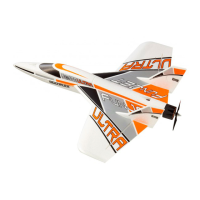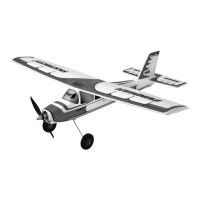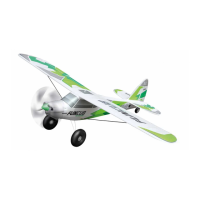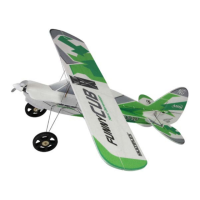21
brackets
㉔
and secure the connection cable to the fuselage side
with a
little hot glue. The cables are fed forward to the motor under the cross bar
– be sure to x the cables to the fuselage side near the motor with hot glue.
22. Mounting the spinner and the propeller
First screw the propeller blades (in the propulsion set # 1-00103 or 1 pair
of # 1-00106) using the cylinder head screws
(M3 x 20 mm) and the
stop nuts
onto the propeller driver
. Tighten the screws until the
propeller blades no longer have any play but can still be retracted slightly;
if necessary adjust the propeller driver.
Now insert the pre-assembled propeller driver on the collet chuck
as
shown. Then slide the entire assembly onto the motor shaft and ensure
the propeller driver remains approx. 1 mm away from the fuselage.
First mount the washer of the driver, then the washer
and the lock
washer
, and nally tighten the nut (M8)
. Make sure the distance
between the propeller driver and the fuselage remains the same while
tightening! The spinner
is afxed with the screw
M2.5 x 12 mm.
Fig. 21
Completing the elevator units
23. Sticking the leading edges to the elevator units
The leading edges
㊻
for the elevator unit halves
7
+
8
are
symmetrical and can be stuck either on the left or right. To do so, place
the elevator unit halves on the table so that the front part protrudes over
the edge of the table. Now draw continuous 'tracks' with Zacki ELAPOR®
on both sides, inside the leading edge, approx. 2 mm away from the edge.
Position the hollow needle of the adhesive on the opposite edge to the
guide and apply adhesive in a straight line. Apply less adhesive toward the
outside. Position the leading edge from the outside ush on the tail unit
and press on it for a while. If necessary, carefully remove any escaping
glue. Do the same with the other half of the tail.
Fig. 22
24. Sticking in the elevator unit wing roots and the struts
Test-t the left elevator unit wing root with the catch
, the right elevator
unit wing root
, and two elevator unit strut tubes
analogous to
the recesses in the left and right elevator unit
7
+
8
. If everything ts,
carefully stick these parts on all contact surfaces to the foam part.
Make sure the struts are fully pressed into the slits in the foam and no
glue gets into the area in which the struts of the other half will later have
to be inserted. At these points, use the glue more sparingly.
Caution: Do not stick the elevator halves together until you have made
sure that the glue has fully hardened. This may take several hours.
25. Making the rudder hinges accessible
Move the elevator aps up and down several times in order to make the
hinges smoother.
Stick the left elevator unit reinforcement tube
(200 mm) into the groove
of the left elevator connector
and press it into the foam while positioned
at.
Likewise, stick the right elevator unit reinforcement tube
(120 mm) into
the right elevator connector with the horn
.
Caution: Do not apply any adhesive to the outer and inner sides of the
plug square.
Fig. 22
26. Affixing the elevator unit to the fuselage
After ensuring the glue has hardened, test-stick the elevator halves
7
+
8
to the fuselage and allow the locking tab to lock into place –
adjust if necessary. Remove the elevator unit again.
Fig. 23
To optimize the stability from the outside, re-stick, if necessary, the
CFRP struts and the stainless steel tubes to the foam with a bit of Zacki
ELAPOR® and put aside until fully hardened. Fix the ends with a bit of
hot glue as well.
27. Preparing the elevator linkage
Mount the safety O-ring
㊳
to the rudder horn
so that it is positioned
behind the four retaining collars.
Screw the hexagon socket set screw
㉘
into the cardan bolt
㉗
.
Mount the cardan bolt in the outer holes of the rudder horn
on the
elevator.
Caution: Only bend the rudder horn apart until the cardan bolt can be
inserted. If you bend it too far apart, the horn may break off! Never use,
e.g., a large screwdriver here as leverage!
28. Connecting the elevator rod
Test-t the elevator unit to the fuselage.
Hook the elevator rod
㉜
(80 mm) from above into the second hole
from the inside on the servo arm, bring the servo and the rudder into the
neutral position and clamp the rod in the cardan bolt.
Fig. 24
Caution when disassembling the elevator unit: First release the rod
by loosening the clamping screw. Then rotate the servo arm forward -
feed the rod out of the cardan bolt and then release the elevator halves
again by disengaging the self-locking mechanism. This is the only way to
ensure the fuselage is not damaged by the cardan bolt.
Hint: Depending on the stress in rough terrain, the elevator hinges may
tear from the outside over time. In this case, they can be reinforced with
PVC hinges order no.: 70 3202 (6 pcs.).
To mount the PVC hinges, use a cutter to cut a suitable slit from the wing
tip in the hinge progression and then stick in the PVC hinge with a little
glue. The pivot must be on the hinge line.
29. Strut tubes in the wings
The high-strength struts are made of carbon ber material (CFRP) coated
with a precision drawn aluminum tube.
The strut tubes
are already tted in the wings, if necessary they should
be slightly deburred on the protruding ends (sandpaper) to ensure the
Building instructions
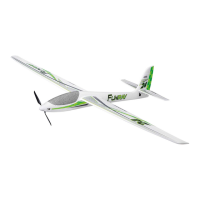
